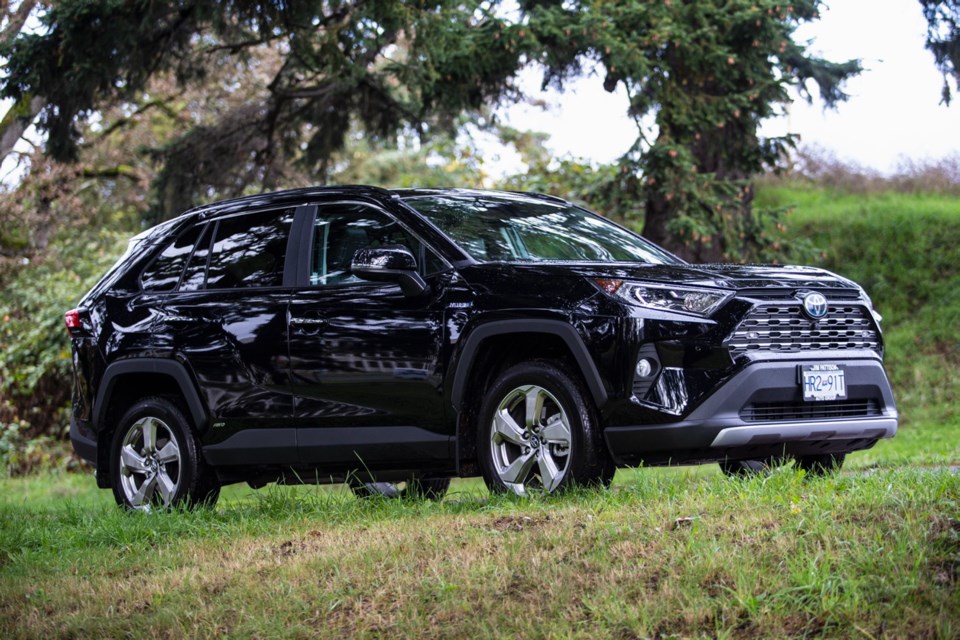Toyota must have read a quote from the late Dr. Wayne Dyer when it was developing the 2019 RAV4 Hybrid.
“My goal is not to be better than anyone else,” said the well-known motivational speaker. “But to be better than I used to be.”
The company took that quote to heart developing the gasoline-electric hybrid, which literally has no direct competitors.
Sure, the conventional gasoline-powered models take on a full slate of competitors in the hot compact SUV/crossover segment of the market, such as the Honda CR-V, Mazda CX-5 and others.
There are, however, a small but growing number of plug-in hybrids, such as the Mitsubishi Outlander PHEV and Kia Niro PHEV.
So you could say that Toyota reasoned that the one to really beat this new vehicle was last year’s RAV4 Hybrid.
Toyota offers the RAV4 Hybrid in three trims, starting at $32,350 for the base model. My tester was the top-of-the-line Limited, with a list price of $42,790.
The RAV4 has just undergone a major revamp, with a more aggressive-looking body on a new platform and an upgraded interior.
But the biggest change took place under the hood. There is still a gas-powered 2.5-litre Atkinson-cycle four-cylinder doing yeoman’s work. It is augmented by two electric motors, one in the front and one in the back.
To give a more engaging drive, Toyota has chosen to have more torque — up to 30 per cent more — flow to the rear wheels. This is a strategy more commonly associated with high-end European sports sedans, not run-of-the-mill SUVs.
This is possible because all RAV4 Hybrids automatically come with AWD.
The gasoline engine produces 176 horsepower and 163 pound-feet of torque. One electric motor produces 118 hp and 149 lb.-ft. of torque while the second adds another 54 hp.
Combined, Toyota claims the Hybrid has 219 hp.
That’s not only more powerful than last year’s powerplant (194 hp combined) but much more powerful than the Outlander PHEV or the Niro.
The extra power is felt on the road, with zippy pickup (just based on seat-of-the-pants estimation).
Despite being quicker, it is also more frugal than last year, with consumption figures of 5.7 litres per 100 km in the city and 6.3 on the highway.
At low speeds and with a charged battery pack, you can creep along just on electric power.
But the battery pack, a nickel-metal-hydride pack with a mere 1.6-kWh capacity, is meager in comparison with the newer entrants.
The Outlander uses a newer lithium-ion battery with a 12.0-kWh capacity. Even the smaller Niro has a 8.9-kWh pack.
The latter two can offer gas-free driving for a limited range. If your commute falls within those limits, you could conceivably drive without filling up for an extended period of time.
The RAV4’s hybrid system is shared with the company’s other well-known hybrid, the Prius. That model now has a plug-in hybrid model — the Prius Prime.
My money is on the RAV4 eventually being equipped with the same system.
For now, the smaller battery is a positive, as it is able to fit under the second-row seats, resulting in no loss of passenger or cargo capacity (compared with the gasoline-powered models).
The interior of the Limited is as near-luxury as you can get in a Toyota. (You can, of course, trade up to a Lexus if you demand more).
The cabin is spacious, logically arranged and functional. Winter-driving Canadians will appreciate such details such as a heated steering wheel and knobs large enough to be operated with a gloved hand. Even the eight-inch infotainment system has two knobs, despite the fact that most people will likely use the steering-wheel-mounted controls.
This year’s RAV4 has a tray (handy for pens and other small items) horizontally just under the dash directly in front of the passenger and to the left of the steering wheel.
The leather front seats feature heat and ventilation, with two memories for the driver’s.
Apart from a back-up camera, the Limited has rear cross-traffic alert with automatic braking. You also get a bird’s-eye view of the ground around your vehicle as an aid to avoid obstacles during parking.
Saving money on fuel is on everybody’s mind, and electric vehicles are a hot topic. Toyota has offered a gasoline-electric hybrid vehicle for more than 22 years now. Not only is it proven, it is still less expensive and more enjoyable to drive.
The RAV4 in conventional gasoline form is one of the top-selling vehicles in Canada. The RAV4 Hybrid, in a class of its own, continues to show the road forward in a changing automobile landscape.
THE SPEC SHEET
Type: Hybrid compact SUV/crossover, front-engine, all-wheel drive
Engine (gasoline): 2.5-litre four cylinder, 176 hp at 5,700 r.p.m., 163 lb.-ft. of torque at 3,600 to 5,200 r.p.m.
Engine (electric) 118 hp, 149 lb.-ft. of torque and 54 hp
Combined power: 219
Battery: 1.6 kWh nickel-metal hydride
Transmission: Continuously variable
Dimensions (mm): Length, 4,596; width, 1,854; height, 1,702; wheelbase, 2,690
Curb weight (kg): 1,724
Price (base/as tested): $42,090/ $44,005 (includes $1,815 freight and PDI and $100 AC tax)
Options: Nil
Tires: 235/55 R18 on alloy wheels
Fuel type: Regular
Fuel economy (L/100km): 5.7 city/ 6.3 highway
Warranty: Three years/60,000 km new car, five years/100,000 km powertrain, eight years/160,000 hybrid component and three years/ unlimited km roadside assistance



